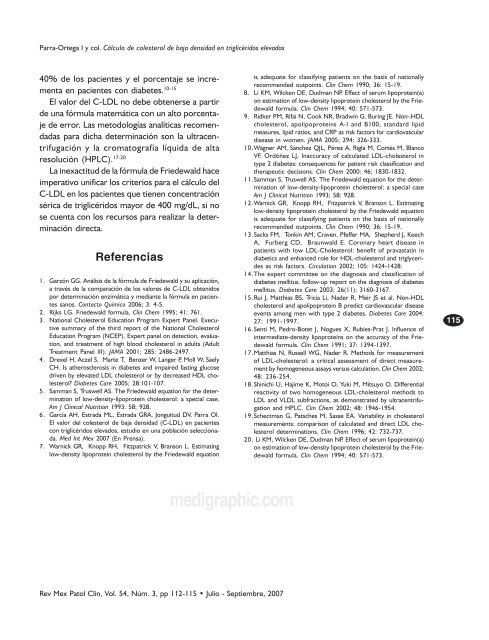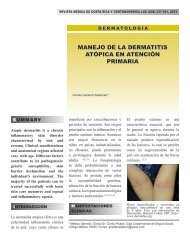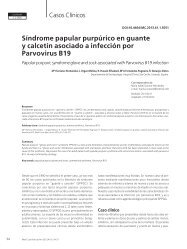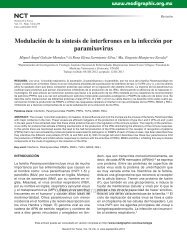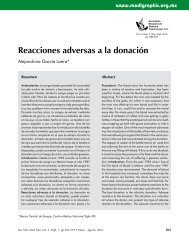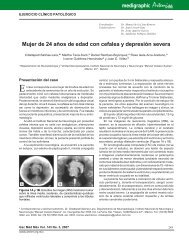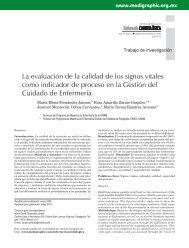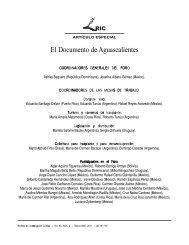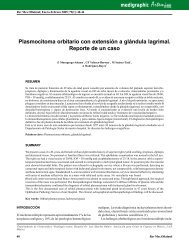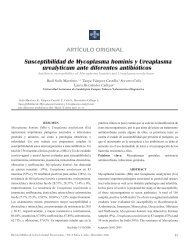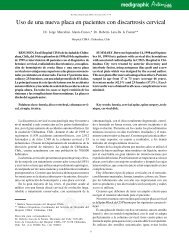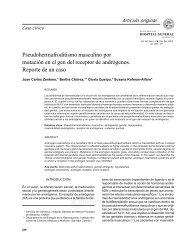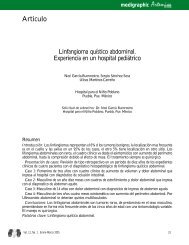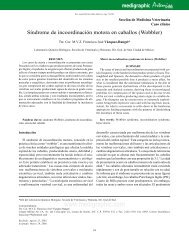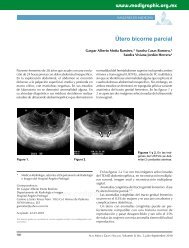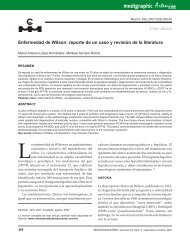La fórmula de Friedewald no debe ser utilizada ... - edigraphic.com
La fórmula de Friedewald no debe ser utilizada ... - edigraphic.com
La fórmula de Friedewald no debe ser utilizada ... - edigraphic.com
Create successful ePaper yourself
Turn your PDF publications into a flip-book with our unique Google optimized e-Paper software.
Parra-Ortega I y col. Cálculo <strong>de</strong> colesterol <strong>de</strong> baja <strong>de</strong>nsidad en triglicéridos elevados<br />
40% <strong>de</strong> los pacientes y el porcentaje se incrementa<br />
en pacientes con diabetes. 10-15<br />
El valor <strong>de</strong>l C-LDL <strong>no</strong> <strong>de</strong>be obtenerse a partir<br />
<strong>de</strong> una <strong>fórmula</strong> matemática con un alto porcentaje<br />
<strong>de</strong> error. <strong>La</strong>s metodologías analíticas re<strong>com</strong>endadas<br />
para dicha <strong>de</strong>terminación son la ultracentrifugación<br />
y la cromatografía líquida <strong>de</strong> alta<br />
resolución (HPLC). 17-20<br />
<strong>La</strong> inexactitud <strong>de</strong> la <strong>fórmula</strong> <strong>de</strong> Frie<strong>de</strong>wald hace<br />
imperativo unificar los criterios para el cálculo <strong>de</strong>l<br />
C-LDL en los pacientes que tienen concentración<br />
sérica <strong>de</strong> triglicéridos mayor <strong>de</strong> 400 mg/dL, si <strong>no</strong><br />
se cuenta con los recursos para realizar la <strong>de</strong>terminación<br />
directa.<br />
Referencias<br />
1. Garzón GG. Análisis <strong>de</strong> la <strong>fórmula</strong> <strong>de</strong> Frie<strong>de</strong>wald y su aplicación,<br />
a través <strong>de</strong> la <strong>com</strong>paración <strong>de</strong> los valores <strong>de</strong> C-LDL obtenidos<br />
por <strong>de</strong>terminación enzimática y mediante la <strong>fórmula</strong> en pacientes<br />
sa<strong>no</strong>s. Contacto Químico 2006; 3: 4-5.<br />
2. Rijks LG. Frie<strong>de</strong>wald formula. Clin Chem 1995; 41: 761.<br />
3. National Cholesterol Education Program Expert Panel. Executive<br />
summary of the third report of the National Cholesterol<br />
Education Program (NCEP). Expert panel on <strong>de</strong>tection, evaluation,<br />
and treatment of high blood cholesterol in adults (Adult<br />
Treatment Panel III). JAMA 2001; 285: 2486-2497.<br />
4. Drexel H, Aczel S, Marte T, Benzer W, <strong>La</strong>nger P, Moll W, Saely<br />
CH. Is atherosclerosis in diabetes and impaired fasting glucose<br />
driven by elevated LDL cholesterol or by <strong>de</strong>creased HDL cholesterol?<br />
Diabetes Care 2005; 28:101-107.<br />
5. Samman S, Truswell AS. The Frie<strong>de</strong>wald equation for the <strong>de</strong>termination<br />
of low-<strong>de</strong>nsity-lipoprotein cholesterol: a special case.<br />
Am J Clinical Nutrition 1993: 58; 928.<br />
6. García AH, Estrada ML, Estrada GRA, Jonguitud DV, Parra OI.<br />
El valor <strong>de</strong>l colesterol <strong>de</strong> baja <strong>de</strong>nsidad (C-LDL) en pacientes<br />
con triglicéridos elevados, estudio en una población seleccionada.<br />
Med Int Mex 2007 (En Prensa).<br />
7. Warnick GR, K<strong>no</strong>pp RH, Fitzpatrick V, Branson L. Estimating<br />
low-<strong>de</strong>nsity lipoprotein cholesterol by the Frie<strong>de</strong>wald equation<br />
is a<strong>de</strong>quate for classifying patients on the basis of nationally<br />
re<strong>com</strong>men<strong>de</strong>d outpoints. Clin Chem 1990; 36: 15-19.<br />
8. Li KM, Wilcken DE, Dudman NP. Effect of <strong>ser</strong>um lipoprotein(a)<br />
on estimation of low-<strong>de</strong>nsity lipoprotein cholesterol by the Frie<strong>de</strong>wald<br />
formula. Clin Chem 1994; 40: 571-573.<br />
9. Ridker PM, Rifai N, Cook NR, Bradwin G, Buring JE. Non–HDL<br />
cholesterol, apolipoproteins A-I and B100, standard lipid<br />
measures, lipid ratios, and CRP as risk factors for cardiovascular<br />
disease in women. JAMA 2005; 294: 326-333.<br />
10.Wägner AM, Sánchez QJL, Pérez A, Rigla M, Cortés M, Blanco<br />
VF, Ordóñez LJ. Inaccuracy of calculated LDL-cholesterol in<br />
type 2 diabetes: consequences for patient risk classification and<br />
therapeutic <strong>de</strong>cisions. Clin Chem 2000: 46; 1830-1832.<br />
11.Samman S, Truswell AS. The Frie<strong>de</strong>wald equation for the <strong>de</strong>termination<br />
of low-<strong>de</strong>nsity-lipoprotein cholesterol: a special case<br />
Am J Clinical Nutrition 1993; 58: 928.<br />
12.Warnick GR, K<strong>no</strong>pp RH, Fitzpatrick V, Branson L. Estimating<br />
low-<strong>de</strong>nsity lipoprotein cholesterol by the Frie<strong>de</strong>wald equation<br />
is a<strong>de</strong>quate for classifying patients on the basis of nationally<br />
re<strong>com</strong>men<strong>de</strong>d outpoints. Clin Chem 1990; 36: 15-19.<br />
13.Sacks FM, Tonkin AM, Craven, Pfeffer MA, Shepherd J, Keech<br />
A, Furberg CD, Braunwald E. Coronary heart disease in<br />
patients with low LDL-Cholesterol: benefit of pravastatin in<br />
diabetics and enhanced role for HDL-cholesterol and triglyceri<strong>de</strong>s<br />
as risk factors. Circulation 2002; 105: 1424-1428.<br />
14.The expert <strong>com</strong>mittee on the diag<strong>no</strong>sis and classification of<br />
diabetes mellitus. follow-up report on the diag<strong>no</strong>sis of diabetes<br />
mellitus. Diabetes Care 2003; 26(11): 3160-3167.<br />
15.Rui J, Matthias BS, Tricia Li, Na<strong>de</strong>r R, Meir JS et al. Non-HDL<br />
cholesterol and apolipoprotein B predict cardiovascular disease<br />
events among men with type 2 diabetes. Diabetes Care 2004:<br />
27; 1991-1997.<br />
16.Senti M, Pedro-Botet J, Nogues X, Rubies-Prat J. Influence of<br />
intermediate-<strong>de</strong>nsity lipoproteins on the accuracy of the Frie<strong>de</strong>wald<br />
formula. Clin Chem 1991; 37: 1394-1397.<br />
17.Matthias N, Russell WG, Na<strong>de</strong>r R. Methods for measurement<br />
of LDL-cholesterol: a critical assessment of direct measurement<br />
by homogeneous assays versus calculation. Clin Chem 2002;<br />
48: 236-254.<br />
18.Shinichi U, Hajime K, Motoi O, Yuki M, Mitsuyo O. Differential<br />
reactivity of two homogeneous LDL-cholesterol methods to<br />
LDL and VLDL subfractions, as <strong>de</strong>monstrated by ultracentrifugation<br />
and HPLC. Clin Chem 2002; 48: 1946-1954.<br />
19.Schectman G, Patsches M, Sasse EA. Variability in cholesterol<br />
measurements: <strong>com</strong>parison of calculated and direct LDL cholesterol<br />
<strong>de</strong>terminations. Clin Chem 1996; 42: 732-737.<br />
20. Li KM, Wilcken DE, Dudman NP. Effect of <strong>ser</strong>um lipoprotein(a)<br />
on estimation of low-<strong>de</strong>nsity lipoprotein cholesterol by the Frie<strong>de</strong>wald<br />
formula. Clin Chem 1994; 40: 571-573.<br />
115<br />
m<strong>edigraphic</strong>.<strong>com</strong><br />
Rev Mex Patol Clin, Vol. 54, Núm. 3, pp 112-115 • Julio - Septiembre, 2007


